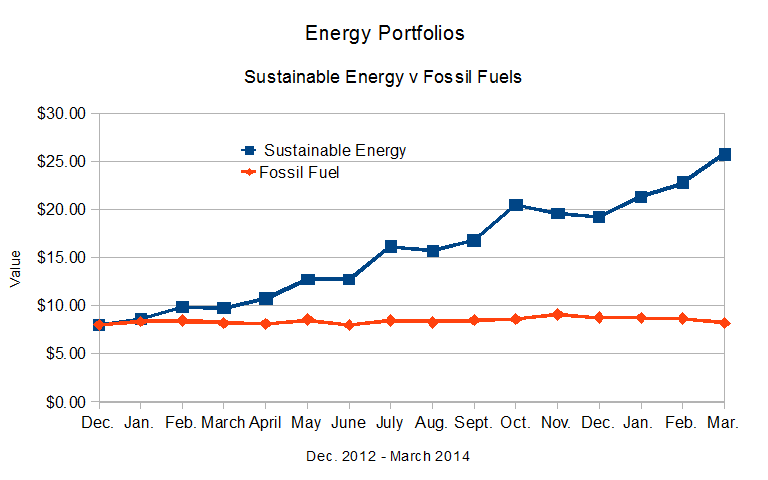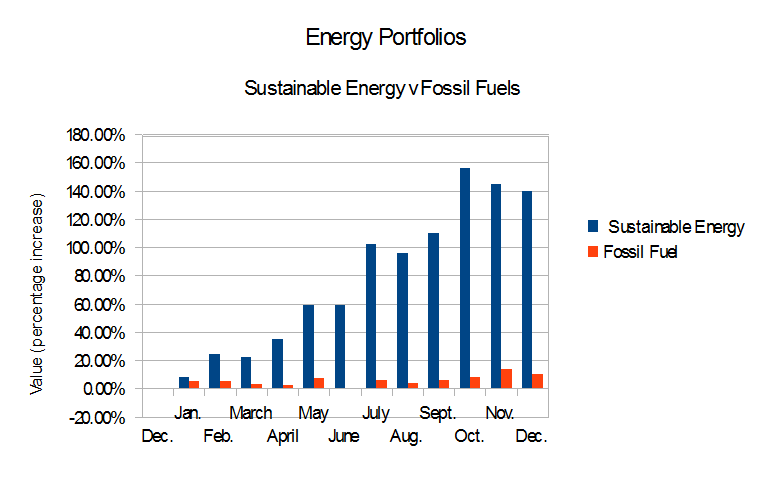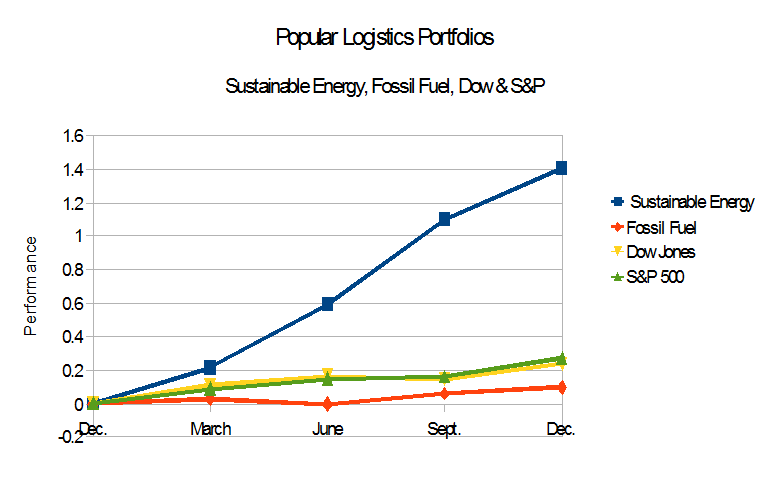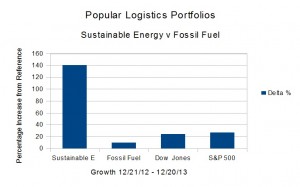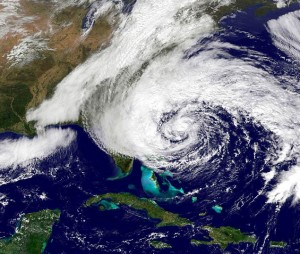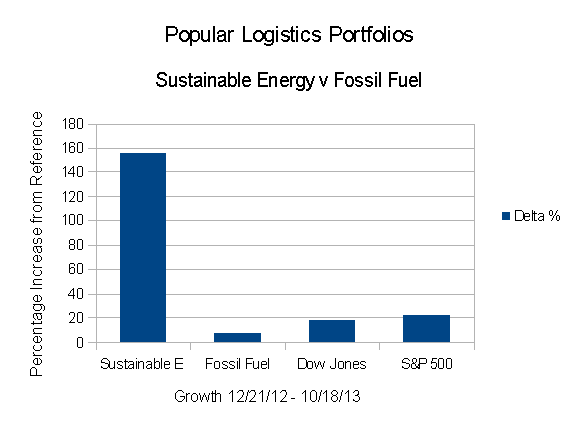On Dec. 21, 2012, I put $16 Million imaginary dollars in equal imaginary investments in 16 real energy companies; Eight in the Sustainable Energy space and eight in the fossil fuel space. The Sustainable Energy portfolio is composed of Cree and Lighting Sciences in the LED space, GTAT, which at the time made solar ovens for cooking PV wafers, and today is diversifying, First Solar and Sunpower in the solar space, Vestas, a wind company, Solazyme a biofuel company and Next Era, a utility. The fossil fuel companies are the oil companies BP, Chevron Texaco, Conoco Phillips, Exxon Mobil and RD Shell, the coal company Peabody Coal, and Haliburton and Transocean, companies in the offshore oil and oil and gas drilling service industries.
Category Archives: Energy
Energy Portfolios: 14 Months: Sustainable up 184.4%: Fossil Fuel up 8.7%
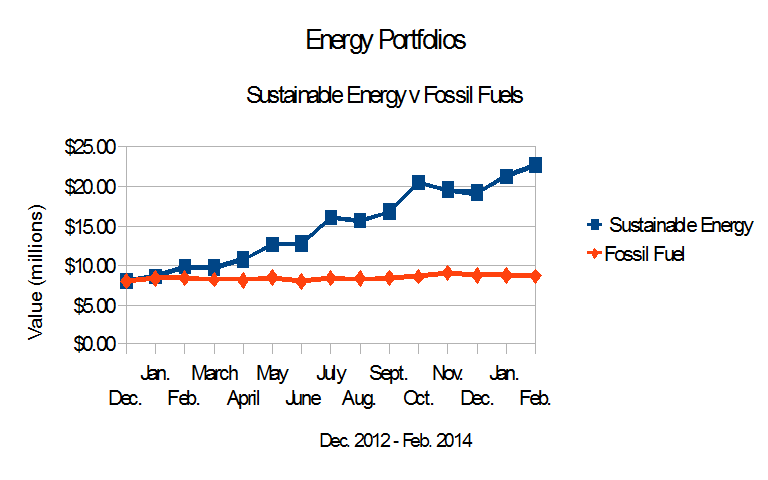 The Dow Jones Industrial Average is up 23.01% from 12/21/12 to 2/21/14.
The Dow Jones Industrial Average is up 23.01% from 12/21/12 to 2/21/14.- The S&P 500 is up 28.39%.
- The Fossil Fuel Portfolio continues to dramatically underperform the reference indices. It is up 8.7% from Dec. 21, 2012.
- The Sustainable Energy portfolio continues to dramatically outperform the averages, and is up 184.41% from Dec. 21, 2012.
Note that the Sustainable Energy portfolio does not include Solar City, SCTY, or Tesla Motors, TSLA. Solar City’s stock price is up 713.0%, from 10.73 on December 21, 2012 to 75.86 at the close of trading Feb. 21, 2014. Tesla is up 614.5% from 34 to 209.60.
Energy Portfolios: 13 Months: Sustainable up 167.4%: Fossil Fuel up 8.92%
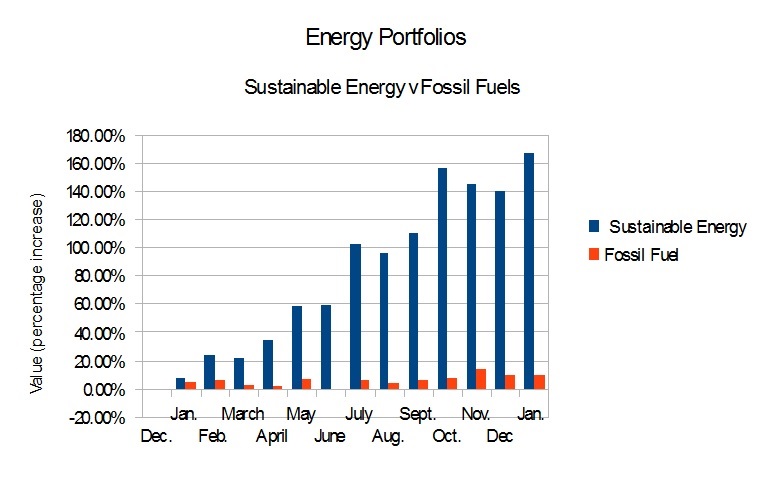 Figure 1, above, shows the relative performance of my hypothetical investments in sustainable Energy and Fossil Fuels, since Dec. 21., 2012.
Figure 1, above, shows the relative performance of my hypothetical investments in sustainable Energy and Fossil Fuels, since Dec. 21., 2012.
- The Dow Jones Industrial Average is up25.38% from 12/21/12.
- The S&P 500 is up28.95%.
- The Fossil Fuel Portfolio continues to dramatically underperform the reference indices. It is up 9.44% from Dec. 21, 2012, and down slightly from Dec. 20, 2013.
- The Sustainable Energy portfolio continues to dramatically outperform the fossil fuel portfolio and the averages, and is up 167.37% from Dec. 21, 2012.
As described in the earlier posts in this series, in Dec., 2012, I read that MidAmerican Energy was buying large scale solar electric generating stations being built by First Solar and Sunpower, and being financed by GE. This got me thinking … Continue reading
Energy Portfolios & Reference Indices, 2013 Summary
If a picture is worth a thousand words …
here are two thousand words on Sustainable Investing in 2013.
While the data may suggest that a “correction” may be in progress for the “Sustainable Energy” portfolio, and while the actions or inactions of various governments can dramatically effect performance of these portfolios, the Sustainable Energy Portfolio outperformed the Dow Jones Industrials and the S&P 500, both of which outperformed the Fossil Fuel Portfolio.
As the professional say, “Past performance is no guarantee of future performance.”
Energy Portfolios At One Year: Sustainable Energy up 140%, Fossil Fuel up 9.85%
On Dec. 21, 2011, reading that MidAmerican Energy was investing in utility scale solar energy generation, I looked at First Solar and Sunpower. Then I looked at six other companies in the sustainable energy world. I created a model portfolio. To make things interesting, I looked at eight companies in the fossil fuel industy and invested $16 Imaginary Million in these 16 companies, $1.0 Imaginary Million in each. As of the close of trading one year later, Friday, Dec. 20, 2013,
- The Dow Jones Industrial Average is up 23.91% from 12/21/12.
- The S&P 500 is up 27.13%.
- The Fossil Fuel Portfolio continues to dramatically underperform the reference indices. It is up 9.85% from Dec. 21, 2012.
- The Sustainable Energy portfolio continues to dramatically outperform the averages, and is up 140.31% from Dec. 21, 2012.
The data are summarized beginning in Table 1, below.
Energy Portfolios: Minor Corrections, Overall Results In Line with the Trend
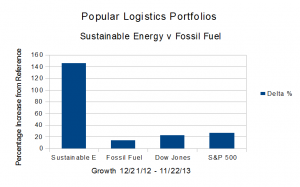 On Dec. 21, 2011, with $16 Imaginary Million, I created an investment simulation. I invested $1.0 Million in imaginary money in each of eight fossil fuel companies and eight sustainable energy companies. As of the close of trading 11 months later, Friday, Nov. 22, 2013, the trend, clearly evident after three months, in March of this year, continues.
On Dec. 21, 2011, with $16 Imaginary Million, I created an investment simulation. I invested $1.0 Million in imaginary money in each of eight fossil fuel companies and eight sustainable energy companies. As of the close of trading 11 months later, Friday, Nov. 22, 2013, the trend, clearly evident after three months, in March of this year, continues.
- The Dow Jones Industrial Average is up 22.72% from 12/21/12.
- The S&P 500 is up 26.22%.
- The Fossil Fuel Portfolio, dramatically underperforming the reference indices, is up 13.37% from Dec. 21, 2012.
- The Sustainable Energy portfolio is up 145.37% from Dec. 21, 2012.
- The Sustainable Energy Portfolio is also down 4.39% from October 18, 2013.
Note that this represents a retreat of 4.39% from the high of 156.14%, in October, 2013.
As discussed in September and October, last month, in Septermber, 2013, in “Investing for the Future,” and October, in “Sustainable Investing: Green Energy, Green Economy,” the important question is: Is this a trend or a bubble? As I wrote, I think it’s a trend.
The 2,000 pound question, after Typhoon Haiyon, Hurricanes Sandy, Irene and Katrina, after the fires of 2012 and 2013, the Missouri River Floods of 2011 – which knocked out the Fort Calhoun nuclear plant – the super-tornadoes of 2013 – one with a two mile wide contact point on land, which tore through Oklahoma (CNN / National Geographic / Zerohedge) is will we survive to make the transition to clean sustainable energy?
or rather:
- “How many of us survive to make this transition?”
- “What will be the carrying capacity of earth for humans?”
The data are summarized beginning in Table 1, below.
In RE Carbon Dioxide – The EPA is Listening
The people at the Environmental Protection Agency understand the issue of increasing atmospheric Carbon Dioxide above 350 PPM. And EPA is listening. EPA has held two public comment periods in New York City on 10/23/13 and will hold nine additional public comment hearings across the country to “solicit ideas and input from the public and stakeholders about the best Clean Air Act approaches to reducing carbon pollution from existing power plants.”
| Boston, MA | 11/04/13 | Philadelphia, PA | 11/08/13 | |
| Chicago, IL | 11/08/13 | San Francisco, CA | 11/05/13 | |
| Dallas, TX | 11/07/13 | Seattle, WA | 11/07/13 | |
| Denver, CO | 10/30/13 | Washington, DC | 11/07/13 | |
| Lenexa, KS | 11/04/13 |
Click HERE to register.
And as President Theodore Roosevelt said, “Speak softly …”
Sustainable Investing: Green Energy, Green Economy
On Dec. 21, 2012, with $16 Imaginary Million, I created an investment simulation. I invested $1.0 Million in imaginary money in each of eight fossil fuel companies and eight sustainable energy companies. As of the close of trading 10 months later, Friday, Oct. 18, 2013, the trend, clearly evident after three months, in March of this year, continues.
- The Dow Jones Industrial Average is up 17.64% from 12/21/12.
- The S&P 500 is up 22.03%.
- The Fossil Fuel Portfolio, dramatically underperforming the reference indices, is up 7.47%.
- The Popular Logistics Sustainable Energy portfolio is up 156.14%.
As discussed last month, in “Investing for the Future,” the important question is: Is this a trend or a bubble? As I wrote, I think it’s a trend.
Jeremy Grantham, the “G” in GMO, invests with the expectation that all things being equal, a company’s valuation tends toward their arithmetic mean values. (Note that Mr. Grantham has not been contacted for this study.) But note that disruptive technologies are, by definition, game changers. Disruptive tech alters the landscape. If you looked at the airline, automobile and railroad industries over the 20th Century, automobiles and airlines waxed while railroads waned.
The future may be similar for Fossil Fuels and Sustainable Energy. The Market Capitalization of the Fossil Fuel portfolio is $1.13 Trillion. The Market Capitalization of the Sustainable Energy Portfolio is $0.06 Trillion ($60 Billion). The value of the companies of the Sustainable Energy portfolio is roughly 5.3% of the market capitalization of the companies of the Fossil Fuel portfolio. It can almost be described as a rounding error compared to the value of the Fossil Fuel portfolio. But if Mr. Grantham’s analysis is valid, and you aggregate the portfolios into one called “Energy” as opposed to a “Fossil Fuel” portfolio and a “Sustainable Energy” portfolio, then the shareholders of these various companies are in for an interesting few years.
Fracking Earthquakes … Fracking Causes Earthquakes
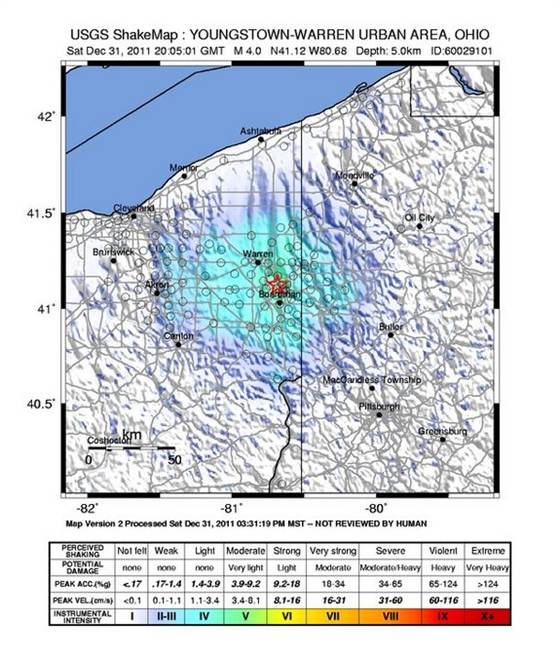
This map shows the intensity of shaking in the area of a magnitude-3.9 earthquake that struck near Youngstown, Ohio, on Dec. 31, 2011. Research has linked this earthquake to the underground injection of wastewater from fracking. Courtesy USGS
As reported on Live Science, here, and NBC News, here, disposal of wastewater from Hydraulic Fracturing, “Fracking,” has been linked to earthquakes in Ohio. As reported in Green, a the NY Times blog, here, fracking has also been linked to increased seismic activity in Oklahoma, altho scientists are uncertain whether the earthquakes are because of the injection of wastewater underground or the extraction of oil and methane via fracking.
This makes perfect sense. Fracking is, after all, injecting explosives under tremendous pressure into underground rock formations, then exploding the rock formations. To expect that not to have other effects – such as earthquakes – would be naive.
Sea Bright, New Jersey, July 11, 2013. I joined Cindy Zipf of Clean Ocean Action, (fact sheet) U.S, Rep Frank Pallone, campaign, and many citizens, including two children, one about 6, the other about 9. We spoke with eloquence, passion, and wisdom of the need to protect the shore, the biosphere, the bio-human-sphere.
“We need to build a clean and sustainable energy infrastructure,” I concluded, “one based on solar, wind, wave, geothermal and sustainable biofuels; an infrastructure for the future. These distributed systems can be designed to withstand natural disasters, human error and terrorist attack. Our future is at stake, and our children’s future.”
I spoke for about 3 minutes, cutting my prepared remarks about in half.
- Press Release: Furman.Port Ambrose LNG.0712 /
- Prepared remarks: L Furman. re LNG Transfer Station.
- Submitted to Regulations.gov, here.
- Surf Rider petition, here.
This is not a partisan issue. Rep Pallone and I are Democrats. Governor Christie is a Republican. The Governor wisely vetoed an identical project in 2011 has promised to veto new deepwater LNG transfer ports. Senator Buono and environmental / citizens groups should hold the governor to his promises. This is a disaster waiting to happen.
We need to look to the rooftops for solar, the oceans for wind and wave power, to geothermal differentials for heat and electricity, to build an infrastructure for the 21st Century.
Fracking – As Clean As Chlorine & Benzene

Quantum chemically calculated magnetically induced probability current density vectors in benzene. Wikimedia Commons
As noted in my post March 24, here, the petrochemical industry says,
“Trust us. The Fracking fluids are water mixed with sand, a few other chemicals, and 5% is household chemicals, like chlorine and benzine.”
The thing is, chlorine and benzene are hazardous. So when the people in the petrochemical industry imply, “This is safe,” because it is household chemicals, I don’t know what they mean. And as documented elsewhere in the series, here, pollution from Fracking is not regulated at the Federal level.
The Celestial Shooting Gallery, Part Four: “You Have Nothing to Worry About (click) Worry About (click) Worry About (click)…”

A stability map of a simple power grid. Each point on this image represents an operating state of a simple power grid consisting of a few generators. Bluish regions constitute stable working states, red unstable and ‘salt-and-pepper’ represent chaotic behavior. One can tune a grid for stability by controlling the phasing of generators and transformers on the grid and such settings suffice for day-to-day operations. It is difficult to decide where, or by how much, abnormalities such as geomagnetic storms might push a system into red, unstable regions, or, worse, salt-and-pepper regions where the system oscillates between states. It is easy to find cases on the map where chaotic regions lie very close to stable regions, indicating that the destabilizing push need not be large at all. James Thorp, Cornell University, published in IEEE Spectrum
People paid to worry about the North American power grid regard geomagnetic storms as “high impact, low-frequency” events, spawning the inevitable acronym: HILF. Low frequency, in that a geomagnetic storm as intense as May 1921, at 5,000 nano-Teslas/minute, or the 1859 Carrington Event, best guess: 7,500 nano-Teslas/minute, might not happen in our lifetimes, the lifetimes of our children, or even our grand children. If signature traces in Arctic ice core samples are correct, these are ‘500 year events.’ When it comes to deciding where to put that preventative maintenance dollar, storm-proofing Oklahoma elementary schools against EF 5 tornadoes seems a far more practical spend than the hardening of electrical grids against a half-theoretical event that might not even happen in 500 years.
What pulls planners up short is the high impact part: the utter god-awfulness of a power grid that crashes and which then can’t boot itself up. There is a self-referential dependency: fixing a dysfunctional power grid requires it to be functional, as key aspects of the manufacturing of transformers need electricity.
Nor can one expect the cavalry to ride in anytime soon, as the vast geographic reach of geomagnetic storms means that one strong enough to take down the North American grid may very likely take down Eurasian grids as well – entire hemispheres could wind up in the toilet, and we only have two hemispheres. That and the statistical variableness to it all: the Carrington 1859 and May 1921 storms, nominally two ‘500 year events’ were, in fact, separated by only sixty-two years.
Where does the buck stop? Continue reading
Celestial Shooting Gallery, Part Three: When a CME Hits the Atmosphere
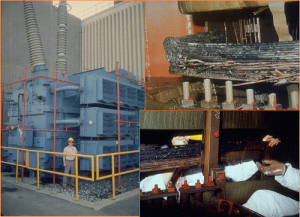
A Generator Step Up (GSU) transformer failed at the Salem River Nuclear Plant during the March 1989 geomagnetic storm. The unit is depicted on the left; some of the burned 22kV primary windings are shown on the right. Though immersed in cooling oil, the windings became hot enough to melt copper, at about 2000 degrees F. John Kappenman, Metatech
Coronal Mass Ejections are mainly charged particles, protons and electrons. When a CME arrives at Earth, the charged protons and electrons come under the influence of the Earth’s own magnetic field, the magnetosphere. Charged particles spin around the lines of magnetic force that comprise the magnetosphere, which diverts most of CME harmlessly around the planet, keeping Earth’s surface tranquil.
If the ejection is large enough, however, it can distort the shape of the magnetosphere, occasionally causing magnetic flux lines to snap and reconnect. When this happens, charged particles leak in and follow the magnetosphere’s flux lines down to the Earth’s ionosphere. There, they strike oxygen and nitrogen molecules and strip them of electrons. These ionized gases glow, giving rise to the ethereal beauty of the auroras around the north and south poles. Unfortunately, these excess charged particles also produce immense electrojets.
Celestial Shooting Gallery, Part Two: The Physics of Geomagnetic Storms
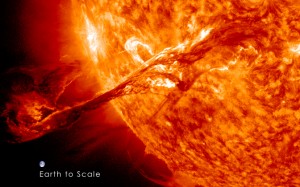
On August 31, 2012 a long filament of solar material that had been hovering in the sun’s atmosphere, the corona, erupted out into space at 4:36 p.m. EDT. The coronal mass ejection, or CME, traveled at over 900 miles per second. The CME did not travel directly toward Earth, but did connect with Earth’s magnetic environment, or magnetosphere, causing aurora to appear on the night of Monday, September 3. The image above includes an image of Earth to show the size of the CME compared to the size of Earth. NASA Goddard Spaceflight Center
Thursday, May 2nd, 2013, a coronal mass ejection (CME) hurled nearly one billion tons of charged particles from the sun’s corona at an outward velocity of one million miles per hour – 270 miles per second.
In less than a half hour, 2,700 virtual Empire State Buildings, 340,000 tons apiece – give or take a few gorillas – erupted from an active region of the Sun’s surface called AR1748, a northern latitude sunspot. AR1748 had just become visible on the western limb of the Sun’s surface when it ejected this mass, so the vast bulk of it hurled outward, not toward us in Libra, but more or less toward Cancer, at right-angles to us. In practical terms, it shot wide of its mark. Still an impressive shot. The CME had been triggered by an M class solar flare, the second largest in a five step scheme (An, Bn, Cn, Mn, Xn; for n a relative magnitude). It had been the largest coronal mass ejection observed thus far in 2013.
And it was still early in the day for AR1748.
Celestial Shooting Gallery, Part One: The Day We Lost Quebec
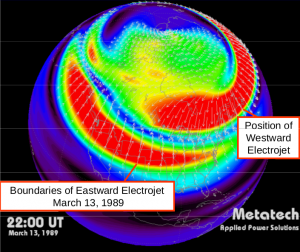
John Kappenman reconstructed the electrojets which formed in the ionosphere late in the March 13, 1989 geomagnetic storm which compromised the Hydro-Quebec power grid in Canada. Concurrently, the eastward jet induced ground currents that severely strained the electrical distribution grid of northern continental United States, resulting in a transformer failure at the Salem Nuclear Power Plant, in New Jersey. Courtesy of Metatech
Nearly a quarter century ago, on March 13, 1989, a geomagnetic storm led to the collapse of the Hydro-Quebec electrical grid system, which furnishes power to much of the province of Quebec, Canada. So pervasive were abnormal currents, that protective circuit breakers tripped throughout the system, bringing the entire grid to a halt in about one and a half minutes. The grid’s self-protective systems were geared toward local abnormalities happening in particular places. In contrast, ground induced currents created abnormalities everywhere. The good news was that most of the hardware protected itself. The bad news was that six million customers were without power for as long as nine hours, and where transformer damage did occur, outages continued for another week.
Further south, the United States experienced a close shave. A second surge in the March 13 storm generated similar ground induced currents in the northern United States, with large current spikes observed from the Pacific Northwest to the mid-Atlantic states, one spike destroying a large GSU transformer at the Salem Nuclear Power Plant in New Jersey. According to John Kappenman, of the Metatech Corporation “It was probably at this time that we came uncomfortably close to triggering a blackout that could have literally extended clear across the country.”
